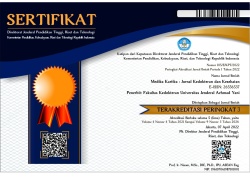KETAKUTAN TERHADAP COVID-19 BERHUBUNGAN DENGAN KECENDERUNGAN GANGGUAN OBSESIF KOMPULSIF PADA DEWASA USIA PRODUKTIF
Abstract
Gangguan obsesif kompulsif/obsessive compulsive disorder (OCD) ditandai adanya pikiran (obsesi) yang mengganggu berulang yang menimbulkan respons berupa perilaku tertentu. Ketika pandemi COVID-19 melanda, terjadi ketakutan terinfeksi penyakit ini yang memengaruhi gejala OCD pada seorang individu dan dilaporkan bahwa prevalensi gangguan obsesif kompulsif meningkat dan mencapai hingga 17,93%. Tujuan penelitian ini adalah menilai hubungan ketakutan terhadap COVID–19 dan kecenderungan gangguan obsesif kompulsif pada dewasa usia produktif. Penelitian menggunakan desain potong lintang dengan subjek 283 dewasa berusia 20-40 tahun berdomisili di DKI Jakarta. Subjek terdiri dari 123 laki-laki dan 160 perempuan. Instrumen penelitian menggunakan kuesioner Fear of COVID-19 Scale (FCV-19S) dan Obsessive Compulsive Inventory-Revised Scale (OCI-R). Pengumpulan data dilakukan pada bulan Oktober sampai Desember 2021. Data dianalisis menggunakan uji Chi-square dengan tingkat kemaknaan nilai p < 0,05. Karakteristik subjek lebih banyak berusia 20-29 tahun (52,3%), didominasi oleh perempuan (56,5%), bekerja sebagai karyawan swasta (49,5%) dan memiliki pendapatan sebanyak 2,7–5 juta per bulan (48,1%). Sebanyak 69,6% subjek takut sampai sangat takut terhadap COVID-19 dan sebanyak 82,3% memiliki kecenderungan gangguan obsesif kompulsif. Uji Chi-square didapatkan p ≤ 0,001 dan disimpulkan terdapat hubungan bermakna antara ketakutan terhadap COVID–19 dan kecenderungan gangguan obsesif kompulsif pada dewasa usia produktif.
Kata kunci: covid-19, dewasa, kompulsif, obsesif, takut
References
2. Rivera RM, Carballea D. Coronavirus: A trigger for OCD and illness anxiety disorder? Psychol Trauma. 2020;12(S1):S66. https://doi.org/10.1037/tra0000725
3. Zheng Y, Xiao L, Xie Y, Wang H, Wang G. Prevalence and characteristics of obsessive-compulsive disorder among urban residents in Wuhan during the stage of regular control of Coronavirus Disease-19 epidemic. Front Psych. 2020;11:1–7. https://doi.org/10.3389/fpsyt.2020.594167
4. Setiati S, Azwar MK. COVID-19 and Indonesia. Acta Med Indones. 2020;52(1):84–9.
5. Storch EA, Sheu JC, Guzick AG, Schneider SC, Cepeda SL, Rombado BR, et al. Impact of the COVID-19 pandemic on exposure and response prevention outcomes in adults and youth with obsessive-compulsive disorder. J Psychres. 2021;295:113597. https://doi.org/10.1016/j.psychres.2020.113597
6. Linde ES, Varga T V., Clotworthy A. Obsessive-Compulsive Disorder during the COVID-19 pandemic—a systematic review. Front Psych. 2022;13(806872):1–20. https://doi.org/10.3389/fpsyt.806872
7. Pakpour AH, Griffiths MD. The fear of COVID-19 and its role in preventive behaviours. J Concurr Dis. 2020;2(1):1–6. https://doi.org/10.54127/WCIC8036
8. Abba-Aji A, Li D, Hrabok M, Shalaby R, Gusnowski A, Vuong W, et al. COVID-19 pandemic and mental health: Prevalence and correlates of new-onset obsessive-compulsive symptoms in a Canadian province. IJERPH. 2020;17(19):1–11. https://doi.org/10.3390/ijerph17196986
9. Chakraborty A, Karmakar S. Impact of COVID-19 on obsessive compulsive disorder (OCD). Iran J Psych. 2020;15(3):256–9. https://doi.org/10.18502/ijps.v15i3.3820
10. Jelinek L, Göritz AS, Miegel F, Moritz S, Kriston L. Predictors of trajectories of obsessive-compulsive symptoms during the COVID-19 pandemic in the general population in Germany. Transl Psychiatry. 2021;11(1):1–11. https://doi.org/10.1038/s41398-021-01419-2
11. Baker MG, Peckham TK, Seixas NS. Estimating the burden of United States workers exposed to infection or disease: a key factor in containing risk of COVID-19 infection. PLoS One. 2020;15(4):4–11. https://doi.org/10.1371/journal.pone.0232452
12. Kassim M, Ayu F, Kamu A, Pang N, Ho C, Algristian H, et al. Indonesian version of the fear of COVID-19 scale: validity and reliability. BEJ. 2020;1(2):124–35. https://doi.org/10.51200/bej.v1i2.2755
13. Stein DJ, Costa DLC, Lochner C, Miguel EC, Reddy YCJ, Shavitt RG, et al. Obsessive–compulsive disorder. Nat Rev Dis Prim. 2019;5(1):1–21. http://dx.doi.org/10.1038/s41572-019-0102-3
14. Clark D, González A. Obsessive-compulsive disorder. In: Emmelkamp P, Ehring T, editors. The Wiley Handbook of Anxiety Disorders [Internet]. Wiley Online Library; 2014. p. 497–534. Available from: https://onlinelibrary.wiley.com/doi/epdf/10.1002/9781118775349.ch24
https://doi.org/10.1002/9781118775349.ch24
15. Fawcett EJ, Power H, Fawcett JM. Women are at greater risk of OCD than men: a meta-analytic review of OCD prevalence worldwide. J Clin Psych. 2020;81(4). https://doi.org/10.4088/JCP.19r13085
16. Chaplin TM. Gender and emotion expression: A developmental contextual perspective. Emot Rev. 2015;7(1):14–21. https://doi.org/10.1177/1754073914544408
17. Sassano-Higgins SA, Pato MT. Obsessive-compulsive disorder: diagnosis, epidemiology, etiology, and treatment. Focus (Madison). 2015;13(2):129–41. https://doi.org/10.1176/appi.focus.130211
18. Hashemloo L, Safaralizadeh F, Bagheriyeh F, Motearefi H. The prevalence obsessive-compulsive disorder in students in Khoy University in 2013. Ijpn. 2014;2(2):13–21.
19. Osland S, Arnold PD, Pringsheim T. The prevalence of diagnosed obsessive compulsive disorder and associated comorbidities: a population-based Canadian study. J Psychres. 2018;268:137–42. https://doi.org/10.1016/j.psychres.2018.07.018
20. Adams TG, Kelmendi B, Brake CA, Gruner P, Badour CL, Pittenger C. The role of stress in the pathogenesis and maintenance of obsessive-compulsive disorder. Chron Stress [Internet]. 2018 Jan 4;2:1–11. https://doi.org/10.1177/2470547018758043
21. Seçer İ, Ulaş S. An investigation of the effect of COVID-19 on OCD in youth in the context of emotional reactivity, experiential avoidance, depression and anxiety. IJMHA. 2021;19:2306–19. https://doi.org/10.1007/s11469-020-00322-z
22. Ji G, Wei W, Yue KC, Li H, Shi LJ, Ma JD, et al. Effects of the COVID-19 pandemic on obsessive-compulsive symptoms among university students: prospective cohort survey study. J Med Intern Res. 2020;22(9):1–13. https://doi.org/10.2196/21915



























